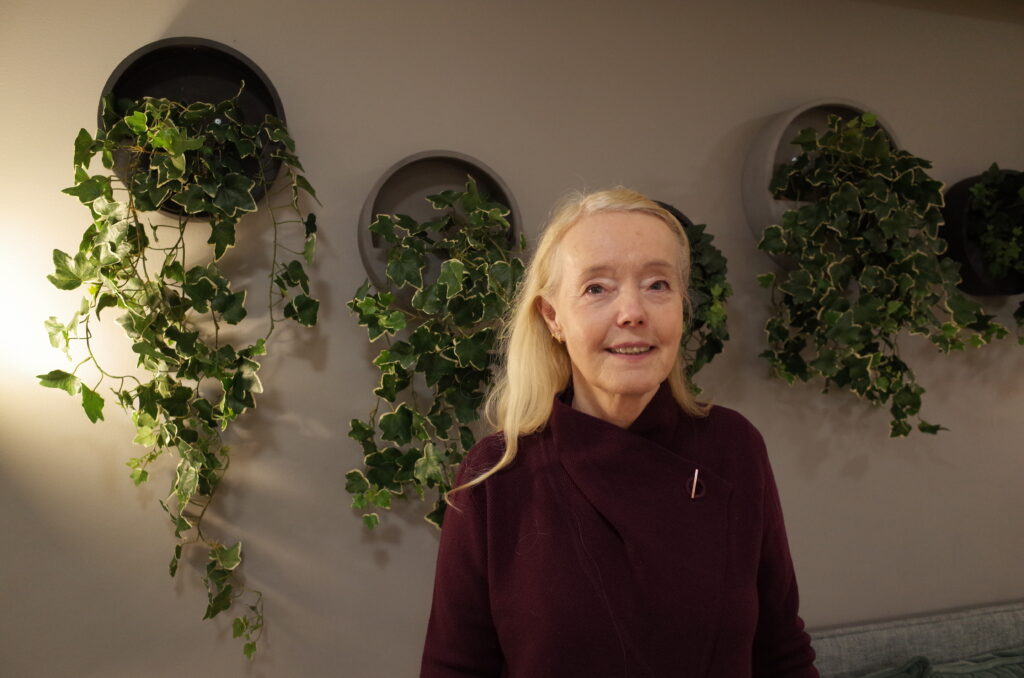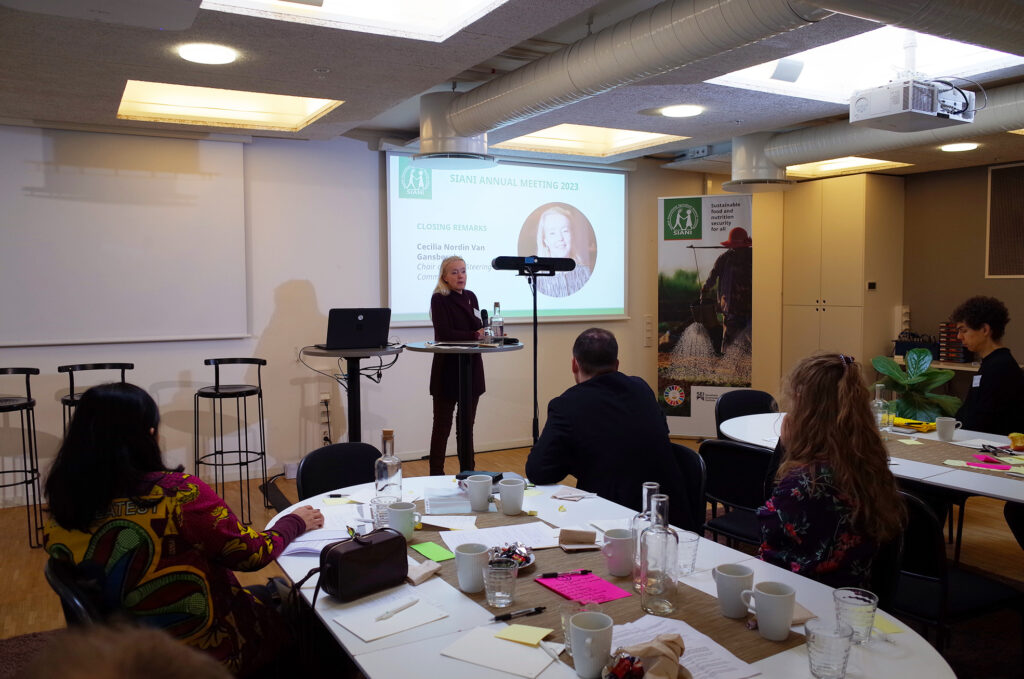
This is an interview piece with Cecilia Nordin Van Gansberghe, Chair of SIANI Steering Committee.
1. Could you tell us more about yourself — how has your work in different organizations and positions strengthened food security over the past years?
With experience working in international institutions, the type of work that is done is sometimes difficult for people outside of the civil servant field to understand. For example, successfully getting an item on the agenda is not an easy task, even though it might seem very simple and straightforward. One has to work very hard and takes into consideration that you’re working for representatives of more than100 governments. They all have their instructions from the capital, and it is not an easy breeze to align everyone’s interests.
In the same logic, it also took a very long time to kick off the discussions on antimicrobial resistance. But finally we managed it, and got it all the way to the UN in New York. Because that is also one thing is that we might be discussing things that FAO in Rome, and people agree on how important the topic is and needs to be addressed; however, when people at the UN in New York would not put the same priority on it. Therefore, despite the long process as most of the work is, one successful contribution could be that AMR has finally come into focus and received attention.
2. Based on your past experiences in the Ministry of Enterprise and Innovation and as an ambassador to FAO, what are the foreseeing events in 2023 that we should be looking out for?
In addition to the high-level UN meetings on food systems, a general rule of thumb is to follow what is happening with the food supply. For instance, in the U.K., they are having a huge shortage of fresh vegetables and fruits now. That is one alarming signal that will drive home to people where the food comes from.
When we ask little kids, where does the milk come from? They would answer ‘the supermarket,’ ‘it comes in a square package from the supermarket.’ Stories like this are not only limited to kids, but many adults have not spent much time thinking about this question either. This kind of information can make people go through the food choices we have access to. The selection at the supermarket is incredible, but they all come from somewhere and it’s all gone through, what we call, ‘the food systems,’ which require a huge apparatus necessary for it to work.
There are also personal concerns over the over-simplification of diets. When one talks about food and eating, there is a tendency to soon jump to the conclusions, e.g. don’t eat this, only eat that. The narrative that one should eat some specific foods and avoid certain ingredients could be problematic. This phenomenon is especially prevalent among younger generations due to social media influence where the algorithm only feeds one with targeted content. Nutrition is all good and fine, and checking one gets the needed nutrition is important. Yet, it would be beyond reasonable to make claims like ‘I’m not gonna eat tomatoes because they don’t have enough nutrition. I will only eat something else.’ That’s one thing I would suggest we could have more of an open and wider view on.
The vivid contrast between underconsumption and overconsumption is another main worry. I have personally dedicated effort to seeing people in the world don’t starve, but the reality is half of the world’s population is overweight nowadays. So the problems of those that don’t have enough to eat is relegated to second place, which to me is absolutely horrifying.
3. Are there any gaps in terms of the agricultural and food systems agendas and priorities across policies at national, regional, and global levels (Sweden, EU and UN)? What should we do to narrow these gaps?
There have been good efforts to link different parts of the food systems, but more must be done. There is an area which is many times lost: the producers who are not small, self-sufficient farmers or large industrial complexes. Small farmers must have the possibility to grow their businesses and not lose support as soon as they seem to be doing well.
Furthermore, changes for sustainability must be rewarding ones for the system or they will not happen. One example can be good animal husbandry that creates good conditions for the animals and removes the cost of medicines such as antibiotics.
For instance, cows can now be fitted with computer interactive collars, that are read by a feeding machine, which delivers exactly the feed that a particular cow needs. Cows should also be able to choose if they want to go outside or stay indoors. They should also be able to spend time with their calf until it has been weaned. There are also cow brushes that looks like car wash for cows to get scratched on their backs.
Sows should be able to spend time with their piglets, have larger pens and not be bound down by limited space. These are so many things that might look small, but they make a real difference to the animals, allowing them to live a healthier life, both physically and mentally.
4. The food system approach to ensuring food security and sustainable agriculture and development is a relatively new approach gaining traction during the Global Food System Summit. What are the advantages and challenges of addressing the problem with this framing?
In my opinion, it is the only way – however complex food systems may seem, they must be taken in their entirety and different parts must actively engage with other parts. Think about it as a murmuration of starlings: thousands of birds all flying in unison because they respect the system, each keeping track of about 7 other birds, i.e. if we all do our small part but in conjunction with the total system, we will be successful. The problem is obviously that it is a daunting prospect to grapple with the entire system, but if many people do many things in many places coordinatedly, it will work.
The major problem for the world to achieve food security is political. For example, Ukraine was food secure before the war started. Most of the time there is enough food in the world to feed everybody, but it’s not in the right place at the right time. It also took political efforts to negotiate taking seeds out from Ukraine, so that they would not just spoil and rot.
Unstable economies with floating currencies, particularly in Africa, can also contribute to food insecurity. Terrorist gangs and robberies that raid a village and burn all their crops are also great threats to food security. There are natural disasters like earthquakes, but they happen much more seldom than political crises and can, to some extent, be mitigated with insurance. Food insecurity from political reasons can be the decision to close national borders. It is way too often that the concern for people’s need for food is less prioritised than the will to govern or win an election. In a country where its democracy and institutions are not strong, food can also be misused as a weapon.
5. As SIANI is entering its new phase, what are your expectations for us in connecting the dots to accelerate the realisation of sustainable food systems?
The fact that SIANI now has secured financing for its next phase, is a clear indication that Sweden considers the work valuable. The work that is being done to connect people and networks is a perfect example of what needs to be done to get closer to food security for all. The ambition must be long-term as people move into and out from networks and positions and the work can thus be seen as onerous. However, the fact that people have moved into new spheres means that the food security work and understanding is being spread throughout and thus helping along food security for all.
6. In connection to Women’s Day this year, how do you see women’s role in contributing to and shaping sustainable food systems as policymakers, scientists, producers and consumers?
It must be remembered that responsibility for food systems lies with us all — it should never be considered as a ”female question”. Women and men must be enabled to participate in creating sustainable food systems on equal terms. It has been proved many times that equality pays in yield and success. If there are still gendered areas, we should try and ”un-gender” them to increase understanding and cooperating among the many parts of the food systems.
Throughout history, people everywhere have learnt that growing things is really hard work, especially when you don’t have any or the right tools. As tools become mechanised and machine-driven, men will tend to take over, leaving the back-breaking work to women. Furthermore, there are examples from Africa, where men controlled the household budget, and in charge of buying the tools for women. They would then select not the most suitable tools, but the cheapest ones. This would obviously be detrimental to the physical health of women, causing back problems, etc. Things like this need to be addressed, in order to allow each and everyone to have influence over their life and work. Some women might be really good at driving tractors, while some men might be great at taking care of the children. So what I would like is more possibility for men and women to choose their roles.
This interview piece is part of SIANI’s ‘Tune in to Food Systems’ interview series composed of monthly interview articles with experts across fields dedicated to sustainable food systems.
